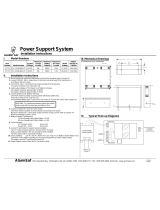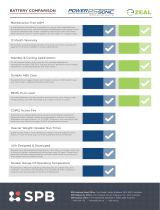Alarm SAF PS5-12040-B03-CSA Installation guide
- Category
- Fire protection
- Type
- Installation guide
This manual is also suitable for

I. Model Numbers
8Ah Max28.2VAC2.50A36Ah4.0A24VDCPS5-24040-B03-UL/CSA/ULC 013XX
20Ah Max17.5VAC1.25A36Ah4.0A12VDCPS5-12040-B03-UL/CSA/ULC 013XX
8Ah Max28.2VAC2.50A38Ah4.0A24VDCPS5-BFS-24-UL/CSA/ULC 01310
20Ah Max17.5VAC1.25A38Ah4.0A12VDCPS5-BFS-12-UL/CSA/ULC 01309
Battery
Storage in
Cabinet
XFMR
Voltage
Max. AC
Input
Current
Max.
Battery
Capacity
System
Current
System
VoltageModel Number
AS
Order
No.
UL1481 - Power Supply/Battery Charger, Guide UTRZ
Power Supply/Battery Charger for use with Listed devices shown in Addendum "A".
UL294 - Access Control Systems Unit Accessory, Guide ALVY
Power Supply/Battery Charger for Access Control Applications
ULC-S527 - Fire Alarm Power Supply/Battery Charger
CSA C22.2 No. 107.1 - Commercial and Industrial Power Supply
* UL Listed Products comply with NFPA 72 - National Fire Alarm Code, and are CSFM Listed
#7315-1214:100 and NY MEA Accepted #MEA 3-92-E
II. Installation Instructions
1. Mount cabinet per mechanical dimensions and knockout locations given in Section IV.
2. Connect 120VAC, 60Hz., single phase to the black and white leads of the transformer in accordance
with Article 725 or 760 of the National Electrical Code, or Article 16 or 32 of the Canadian Electrical
Code.
3. Low Volt AC Input - Connect to secondary winding of the transformer.
v Fused at 10 Amps (Fuse Type AGC-10)
4. Verify output voltage at "DC Output" and "Battery" terminals.
12V system measures approximately 13.8VDC.
24V system measures approximately 27.6VDC.
5. Connect battery set to "Battery" terminals.
CAUTION: Observe polarity; incorrect polarity will destroy battery fuse.
Fused at 10 Amps (Fuse Type AGC-10).
Recommended battery type - PowerSonic (PSSeries) or YUASA (NPSeries) sealed lead acid/gel cell.
6. Connect "DC Output" to input of user system.
CAUTION: Observe polarity; incorrect polarity may damage user system.
Refer to Section I for Maximum Allowable System Current.
7. Visual Indicators:
AC Presence LED1: Green LED
Fault Condition LED3: Yellow LED (PS5-BFS)
System OK LED3: Green LED (PS5-B03)
8. Connect "Fault Output" to system fault annunciation.
PS5-BFS Models: Current limited voltage output
12V system; short circuit fault current is 25mA maximum.
24V system; short circuit fault current is 50mA maximum.
For fault reporting in fire applications, use Relay Module RBKS-124P or RBKS-124N: See Section III.
PS5-B03 Models: Form "C" relay contacts; rated 1A @ 24VDC
9. Fault Conditions: Low AC / No AC / Blown AC Fuse / Low Battery / Blown Battery Fuse
CAUTION: Fault condition reporting may be delayed dependent on power supply loading.
The battery set is NOT supervised for presence.
10. This unit is intended to be placed in the same room as the control equipment.
11. UL and ULC Battery Standby Information for proper operation of this unit:
a. For 60 hr. standby with 18Ah battery set: Max standby draw: .15A, Max 5 minute alarm current: 3A.
b. For 24 hr. standby with 18Ah battery set: Max standby draw: .4A,
Max 5 minute alarm current: 3A.
c. For 60 hr. standby with 36Ah battery set: Max standby draw: .5A,
Max 5 minute alarm current: 2A.
d. For 24 hr. standby with 36Ah battery set - Max standby draw: 1A,
Max 5 minute alarm current: 2A.
e. For 4 hr. standby with 20 Ah battery set - Max standby draw: 3A,
Max 5 minute alarm current: 4A.
12. Power Supply System Draw (No AC, No load) is 25mA.
III. Typical Hook-up Diagrams
{ To Convert the Voltage Fault Output to a Form C relay contact output
The relay will activate on a fault condition.
{ To Convert the Voltage Fault Output to a Form C relay contact output
The relay will deactivate on a fault condition (Fail-Safe Supervision)
Power Supply/Battery Chargers
Installation Instructions
AlarmSaf
w 65A Industrial Way w Wilmington, MA USA 01887-3499 w (978) 658-6717 w FAX: (978) 658-8638 Web Site: www.alarmsaf.com
52-130Z
090897
{ Power Supply Output
Terminal Designations
Caution
For continuous protection against
fire hazard, replace only with the
same type and rating of fuse
Caution: Voltage Fault Output
Not for Fire Protective
Signaling Use.
Use for general purpose only.
Low Voltage
AC Connect
Battery
Connect
AC Fuse
AGC-10
AC
LED
AGC-10
Battery
Fuse
PS5-UL Board
DC
Output
+
Fault
Output
DC
Output
+
+
Fault
Output
Fault
LED
PS-5 UL Board With Relay
+
Low Voltage
AC Connect
Battery
Connect
AC
LED
NC
C
NO
Fault
LED
AC Fuse
AGC-10
AGC-10
Battery
Fuse

IV. Mechanical Drawing
15.38
1.16
0
9.94
1.81
0
13.56
4.34
1.94 TYP
15.00
9.06
3.00
KEY LOCK
11.00
0
2.12
V. Hook-Up Diagram
VI. Troubleshooting Guide
Fault Output
PS5-BFS Models: Current limited voltage output
v 12V system; short circuit current is 25mA max
v 24V system; short circuit current is 50mA max
v For fault reporting in fire applications, use Relay
Module RBKS-124P or RBKS-124N: See
Section III.
v RBKS-124N required to detect AC fault when
no batteries are connected.
PS5-B03 Models: Form "C" relay contacts
v Contacts rated 1A @ 24VDC
v Fail-safe; active until an actual fault condition.
Visual Indicators
1. AC Presence LED1: Green LED
2. Fault LED3 (PS5-BFS): Yellow LED
System OK LED3 (PS5-B03): Green LED
3. LED2 (Red LED) serves no user function.
4. Fault Conditions
Flashing Yellow LED (PS5-BFS) or Green
LED extinguishes (PS5-B03) on:
*Low AC / No AC / Blown AC Fuse
*Low Battery
*Blown Battery Fuse
VII Troubleshooting Chart
Power Supply/Battery Chargers
Installation Instructions
AlarmSaf
w 65A Industrial Way w Wilmington, MA USA 01887-3499 w (978) 658-6717 w FAX: (978) 658-8638 Web Site: www.alarmsaf.com
52-130Z
090897
For further assistance, please contact the AlarmSaf Technical Service Department.
Rewire battery set.Incorrect battery
hook-up.
Remove primary power and batteries, then
replace fuse. CAUTION.
Blown battery fuse.4) No battery back-up
Verify switch settings in Section III.Incorrect switch
setting.
Measure xfmr secondary voltage. If not within
proper range, replace transformer.
Incorrect or defective
xfmr.
Rewire battery set.Incorrect battery
hook-up.
Remove system load and batteries; check
system output voltage. If OK recheck system
requirements, and/or measure output current
draw with an ammeter.
The system load is
greater than the
supply capability.
Check battery condition and replace if needed.Defective battery.3) Incorrect output voltage
Check xfmr secondary voltage at PC board
"Low Voltage AC Connection". If voltage is not
present, replace xfmr.
Loss of transformer
(xfmr) power.
Remove primary power and batteries, then
replace fuse. CAUTION.
Blown AC fuse.
Check AC primary supply.Loss of AC power.2) Green "AC" LED is not
illuminated.
See Symptom 4.Blown battery fuse.
See Symptom 3.Low battery."Fault Output" reporting
See Symptom 2.Low AC / No AC /
Blown AC fuse.
1) Yellow "Fault" LED is flashing;
or Green "Fault" LED is off.
Correction ProcedurePossible CauseSymptoms
AC FUSE (AGC-10)
BATT FUSE (AGC-10)
-
 1
1
-
 2
2
Alarm SAF PS5-12040-B03-CSA Installation guide
- Category
- Fire protection
- Type
- Installation guide
- This manual is also suitable for
Ask a question and I''ll find the answer in the document
Finding information in a document is now easier with AI
Related papers
Other documents
-
 AlarmSaf PSC-12100-B04-CE Installation guide
AlarmSaf PSC-12100-B04-CE Installation guide
-
Targus APTB03 Datasheet
-
 Alvi Smart Installation guide
Alvi Smart Installation guide
-
protech BFS-180 User manual
-
Tascam PocketStudio 5 Frequently Asked Questions Manual
-
Lightolier Low Voltage Transfer Circuit LTC User manual
-
GEM PSU320-12 User manual
-
 CENTURY YUASA ZEAL Battery S4884ABOX 12V 7AMP BATTERY 5 x PER BOX User manual
CENTURY YUASA ZEAL Battery S4884ABOX 12V 7AMP BATTERY 5 x PER BOX User manual
-
Gianni Industries PSU320 Installation guide
-
Minolta Di850 User manual










